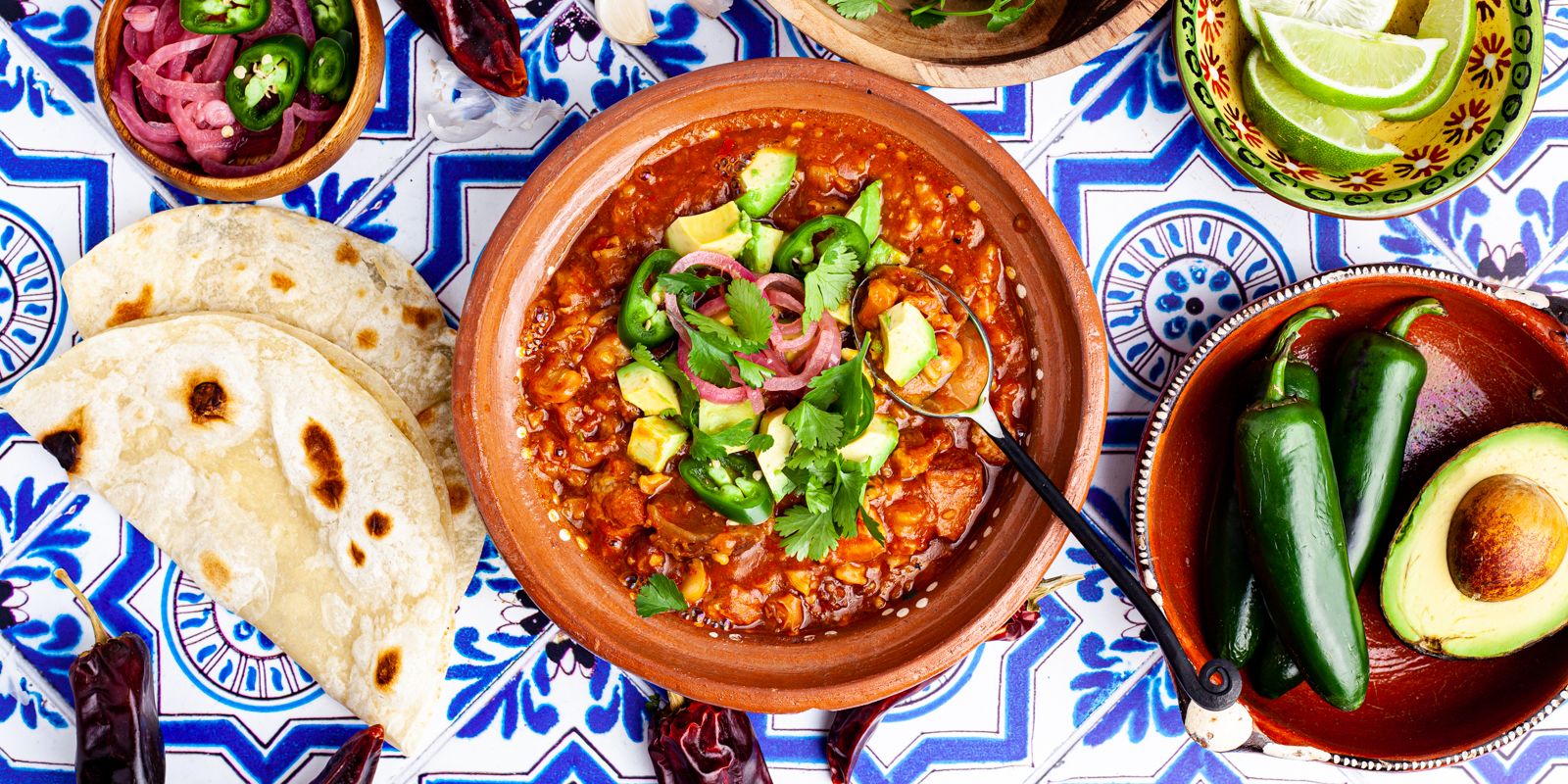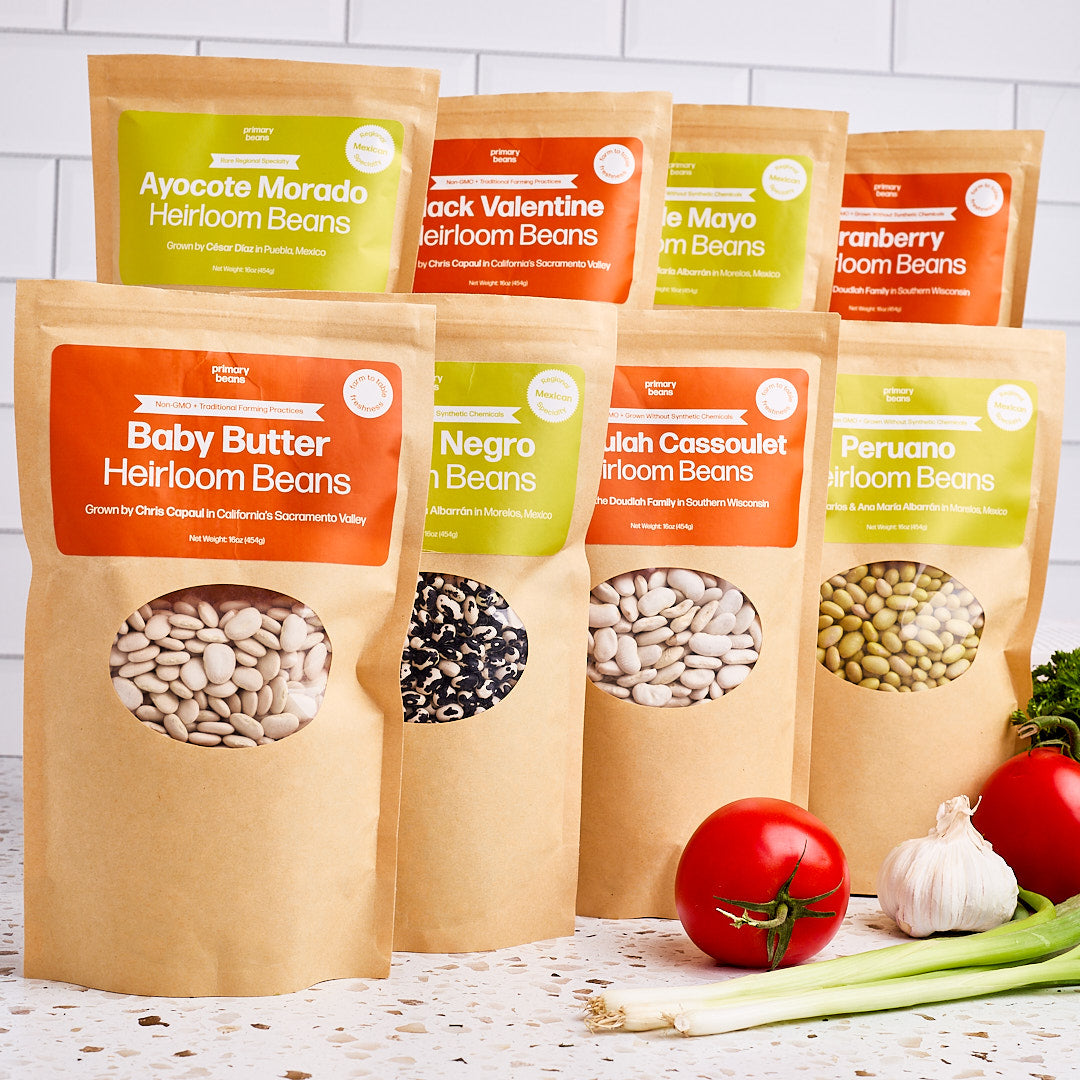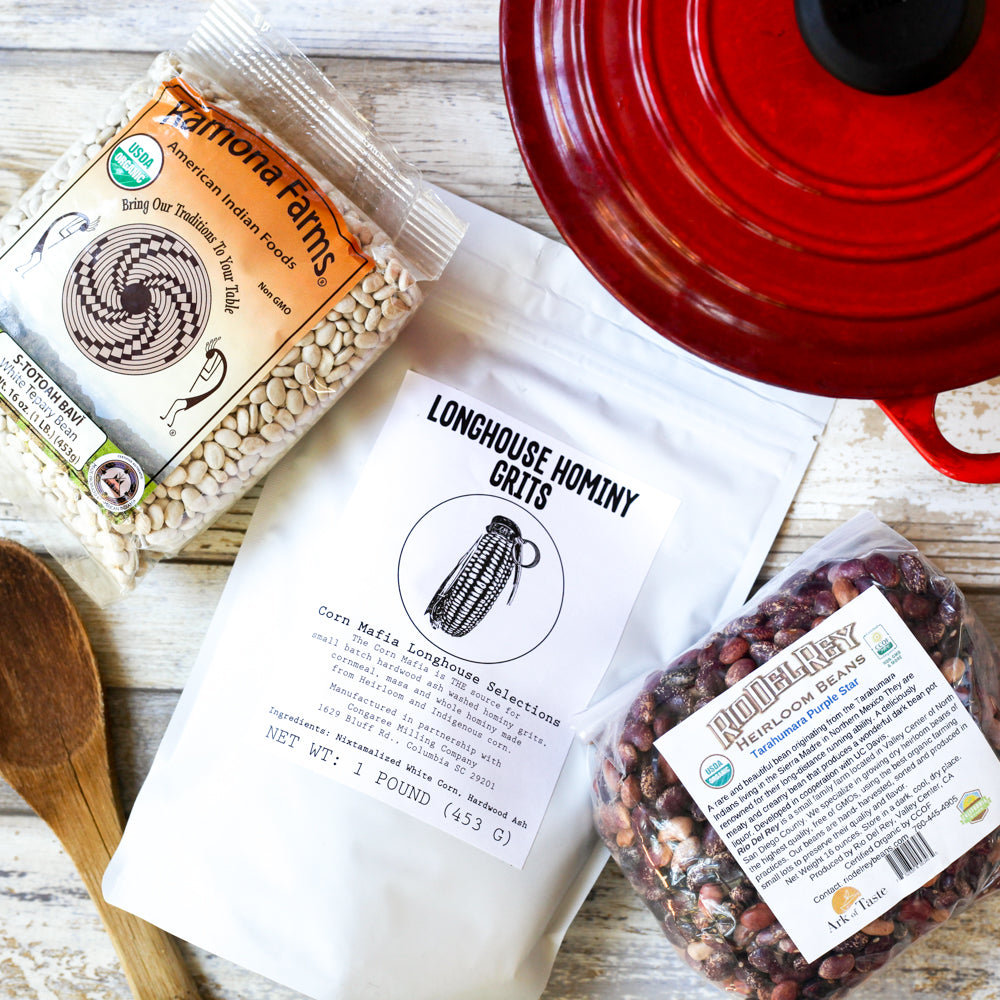10.99 FLAT RATE SHIPPING
10.99 FLAT RATE SHIPPING
SHOP

Traditional Pozole Rojo
February 07, 2023 6 min read
Recipe By Chef Dave Smoke McCluskey
Pozole rojo (or red pozole) is a beloved Mexican soup that has been enjoyed for centuries. This traditional recipe from Chef Dave Smoke McCluskey serves up a taste of the past with hominy made from heirloom corn that has been nixtamalized with wood ash, lending the stew deep and complex flavors with a hint of smoke. This is a pozole for real pozole fanatics featuring a rich home made pork broth with scorched onions, and toasted whole chilis that compliments, rather than overwhelms, the taste of the corn which is truly the star.

What Is Pozole
Pozole rojo is believed to have originated in the ancient city of Tehuacan, located in central Mexico. This traditional food was likely created by the Aztecs who used it to celebrate special occasions and religious festivals. Pozole gets its name from the Nahuatl word for hominy, the delicious kernels of Maize that are central to the dish.
Pozole comes in three main varieties: Rojo, Verde and Blanco. Pozole Rojo is a red version of the dish which is made with a tomato-based sauce and chiles for heat. Pozole Verde is a green version of the dish, which is made with tomatillos and herbs like cilantro, oregano and epazote for flavor. Pozole Blanco is a white version of the dish which is made without a sauce and with milder ingredients like garlic and onions.
Dry vs. Canned Hominy
There are two types of hominy that you can use in pozole: dry or canned. Canned hominy is already cooked and can be used without soaking, while dry hominy must first be soaked before it can be cooked. While both types of hominy will work for pozole rojo, pozole aficionados prefer to use dry hominy as it has a better flavor and texture. The key is to soak the hominy for at least 6 hours or overnight until it is soft and plump.
Whole Dried Chilis
The other key ingredients for pozole rojo are chiles and pork. Using whole chilis rather than powdered is essential to developing flavor in the broth. Ancho and guajillo chiles are traditional and work well together, providing a mildly spicy flavor. These are low-heat chilis that provide complex flavors without a ton of fire. The corn balances any heat from the chilis resulting in a delectable stew that will satisfy everyone at the table. Serving with hot sauce and sliced fresh chilis allow everyone to adjust to their spice preference.
Colonialization And The Dark History Of Pozole
When Chef McCluskey and I were working on writing down his recipe he said "no radish or cabbage" because he wanted to stay away from colonialized ingredients (radish came from Asia, the cabbage we both agree is just weird in Mexican food). Then I pointed out that both cilantro and limes came to Mexico from the Spaniards in the 1500s, which he knew because he's one of the most knowledgeable people I've ever met when it comes to food history. In fact what we now know as Pozole has remained largely unchanged since the arrival of the Spanish, but prior to that it was a whole different animal...literally.
Pozole rojo has a dark past that dates back to Aztec ceremonies. During these events, the soup was used in ritualistic human sacrifice offerings as a tribute to their gods. The Spanish outlawed the use of human sacrifice. Pork which came from the Spanish (apparently the other white meat of the 1500s) was substituted for humans.
If you wanted to make a pre-colonial version without picking off the weakest and slowest neighbor on your block, you could use turkey, rabbit, or other wild game and serve it with green onion, jalapeno, and avocado.

ABOUT CHEF DAVE SMOKE McCLUSKEY
Once upon a pandemic a Mohawk chef found a new calling and the results are irresistible. Chef Dave Smoke McCluskey, founder of Corn Mafia closed his restaurant to pursue his passion for the most important of all indigenous ingredients, corn. He has been described as a colorful character and that's a pretty tame interpretation. As a Mohawk he takes his job as a "keeper of the Eastern door" very seriously. As a chef he takes the availability of good clean food very seriously. His culinary career spanned over 40 years and it is the marriage of the mind of a chef and the soul of a Mohawk that creates such transformative ingredients as his Longhouse Hominy Grits. He is a food educator and currently serves as a Slow Food Ark of Taste Board Member.
This is one of the recipes featured in our heirloom bean and grain club, celebrating small, family owned farms, millers and makers like Corn Mafia. Members of the club enjoy rare ingredients shipped to their doorstep each month with recipes and information about the ingredients and the farmers that grew them. Get on the wait list now to be notified the next time we open the doors.
RECIPE NOTES AND DESCRIPTIONS
HOW TO PREPARE DRIED HOMINY
Cooking with dried hominy is a bit like cooking with dried beans. Dried hominy need to be fully hydrated and boiled in water or stock until it has no chalky texture. This recipe calls for soaking overnight and then cooking for 30 minutes before adding to the soup where it is cooked for another 2 hours until tender. If you forget to soak overnight simply cook the hominy for an hour or more before adding to the pot. You can also cook hominy in a pressure cooker for 20 minutes with no soaking. Having tested all methods they all end up about the same in texture, taste and appearance. Hominy "pops" when it cooks, losing it's corn kernel shape. I have experimented with soaking and simmering on low to see if I could keep the kernels more intact but no matter what I tried, they looked the exact same way by the time there is no trace of chalky texture.
HOW TO TOAST WHOLE DRIED CHILIS
To toast whole dried chilis, start by removing any stems. Remove the seeds for a milder heat, keep them for more spice. Heat a heavy-bottomed skillet or frying pan on medium heat for a couple of minutes, then place the dried chilis in the hot skillet, pressing them gently with tongs or a spatula. Toast for about 15-30 seconds on each side until they puff up slightly and release a rich aroma, being careful not to burn them. They don't puff up like popcorn, it's subtle. Burned chilis have a bitter taste so err on the side of less toasted rather than more. Smell is a much better indicator than puff or color. They should go from a totally neutral smell to slightly fragrant.
MAKING THE BROTH
Making the broth takes several steps and is worth reading through before starting. FYI you can make the broth a day or two ahead and keep it in an airtight container in the refrigerator.
The first step in the broth is to scorch half of the onion and tomato by putting them directly over the flame of a gas burner, your grill or under the broiler. You want a nice a char on the outside with brown and black bits which will lend a fire roasted flavor to the broth.
Boil the toasted onion and tomatoes with the toasted chilis with the ham hocks. This is the basis of the broth and where the liquid comes from. After about an hour when the hocks are tender and cooked through remove the hocks and set them aside but put everything else, including the tomatoes, onion and chilis, in the blender but don't blend yet. Next make the browned garlic in a skillet large enough to brown the pork in. Watch the garlic carefully and make sure the heat is not too high so that you don't burn the garlic. If you do, throw out the garlic and the oil and start over with fresh oil. With a slotted spoon transfer the garlic to the blender but leave the garlic oil in the pan for the pork. Blend the red broth mixture on high until it is a smooth puree.
TRADITIONAL POZOLE ROJO
Rated 4.3 stars by 3 users
Category
Soup
Cuisine
Mexican
Servings
4-6
Prep Time
30 minutes
Cook Time
3 hours
This is a pozole for real pozole fanatics featuring heirloom, dried hominy, a rich home made pork broth with scorched onions, and toasted whole chilis that compliments, rather than overwhelms, the taste of the corn which is truly the star.
Lisa Riznikove

Ingredients
- 1 pounds of Fat Red Hominy or Becky Blanca Hominy from Corn Mafia
- 2-3 Ham Hocks (if you can't find ham hocks you can use a ham shank or bacon and pork shoulder)
- 2 pounds 1” cubed Pork Shoulder or Butt
- 1 large yellow onions, 1/2 peeled, halved and roasted over a burner to scorch, the rest cut into 1” dice
- 4-5 cloves of garlic, smashed
-
5 Whole Dried Guajillo, seeded and stemmed, toasted
-
5 Ancho Chiles, seeded and stemmed, toasted
- 2 tomatoes, scorched
- 2 Tbsp of corn or vegetable oil
- 1 teaspoon ground Cumin
- 1 teaspoon Chili Powder
-
1 teaspoon Mexican Oregano
- Salt & Cracked Black Pepper
-
1-2 Avocados, sliced or cubed
- 1 small red onion minced
- 1-2 fresh Jalapeños sliced thin
- Freshly fried tortilla chips
- Cilantro leaves
- Fresh Lime wedges
- Hot Sauce
- Pickled Red Onion for garnish (recipe below)
- 1 large red onion thinly sliced
- 1 cup white or apple cider vinegar
- 1/2 cup water
- 1 teaspoon salt
- 1 tablespoon sugar
-
Black Peppercorns, slices of jalapeño, fennel or other aromatics (optional)
OPTIONAL GARNISHES
PICKLED RED ONION
Directions
Make The Pickled Onions
Put the sliced onion and the peppercorns or other aromatics in a ball jar, pushing them down tightly. Combine the remaining ingredients in a sauce pan and bring to a boil. Stir until the salt and sugar are dissolved and pour over the onions. Refrigerate for at least 1 hour or up to a week.
Prepare The Hominy (See the notes above)
- Rinse and Soak the hominy over night.
Drain the hominy and add to a separate pot with enough fresh water to cover by 2 inches, bring to a boil and then simmer on a low flame for 30 minutes. You can do this step while the broth is simmering or prepare the hominy ahead and keep it in the refrigerator in the boiling water for up to 2 days.
Make The Broth
Scorch half the onion and the tomato by putting them directly over the flame of a gas burner or your grill. If you don't have a gas stove you can put them under the broiler briefly until a bit of char develops.
In a large pot, add the ham hocks, scorched onion, scorched tomatoes and chiles and add enough water to cover by 2-4 inches. (this is the basis of the broth) Bring to a boil and then simmer until hocks are tender (about an hour). Remove the hocks and set them aside for later. Put the rest of the broth contents including the onion, tomato and chilis into a blender.
In a small pan, add the corn oil, and sauté the garlic until browned being careful not to burn it. Remove the garlic with a slotted spoon reserving the oil to cook the pork in later.
Add the browned garlic to the blender with the broth contents and blend on high until the broth is a smooth puree.
Prepare The Pork
Season cubed pork with the cumin, chile powder, Mexican oregano, salt and pepper to your liking.
Brown in the strained garlic oil from the broth in batches if need be.
While the pork browns, remove the skin and meat from the hocks. Thinly slice the meat and reserve.
Make The Pozole
Add the remaining diced yellow onion, pork, hock, the red broth you have made in the steps above, rinsed hominy and additional water (if needed), to the pot.
Bring to a boil, and simmer until pork and hominy are tender about 2 hours.
When the pork and hominy tender enough to your liking, adjust seasonings, and ladle into bowls.
Garnish And Serve
Think of pozole as the original chili and garnish it up to your heart’s content. I like to lay out a tray of options including the pickled onions and let gets go wild adding what they like to the soup. Options include avocados, chopped red onion, scallions, cilantro, tortilla chips, limes and hot sauce.
Recent Articles
About Us
Foodocracy is dedicated to creating a more sustainable and independent food system. We support small, independent farms across the nation.
Related Recipes
Get impossible to find beans and grains shipped direct to your doorstep each month from small family farms.
We support small, family owned farms across the nation. Did you know that farmers only make an average of 10 cents on every dollar you spend at the supermarket? Working directly with farms and not middle men ensures that more money goes back to the people actually growning your food.
Get 10% Off
Sign up for delicious recipes and special offers.
**Regularly priced items only.








